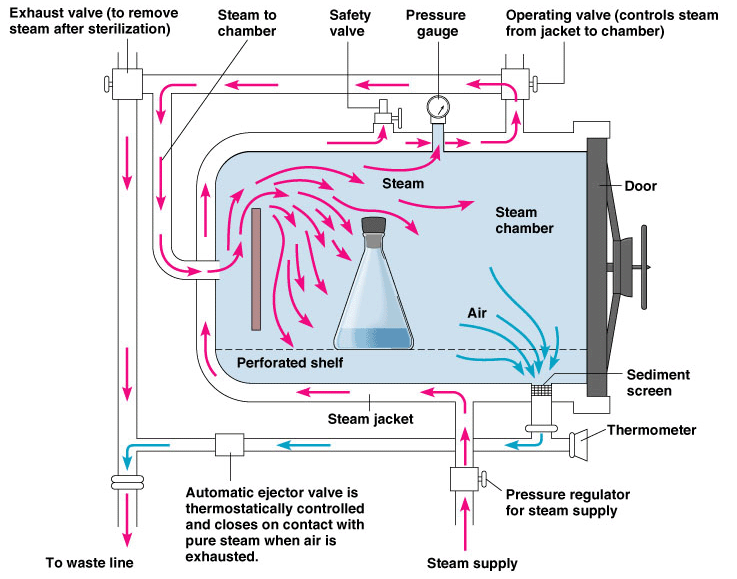Moist heat sterilization is a method of sterilizing equipment, tools, and other materials. This process involves exposing items to high temperatures in the presence of moisture.
Moist heat sterilization principle:
Steam has high penetration power in the form of latent heat. This latent heat causes the coagulation of proteins. During moist heat sterilization, high temperatures along with steam kill microbes by denaturing their proteins and other cellular components.
Sterilization with moist heat can be performed at variety of temperatures. In each method there is use of different temperatures and time as per nature of the item to be sterilized and its thermolability.
1. Sterilization at temperature below 100 °C
2. Sterilization at temperature at 100 °C
3. Sterilization at temperature above 100 °C
1. Sterilization at temperature below 100 °C
A) Pasteurization
Pasteurization is an example of moist heat sterilization below 100 °C. This method is suitable for the treatment of food such as milk and drinks. The normal pasteurization temperature is 63°C (145°F) for 30 minutes or 72°C (161°F) for 15 seconds. This temperature not only kills pathogenic microorganisms but also preserves the quality of food or beverage.
Sterilization at temperature at 100 oC
A) Tyndallization
Tyndallization is moist heat sterilization method for heat-sensitive objects for which autoclaving is not possible. In this method involves exposure of materials to steam of 100°C for 30 minutes then it is left for incubation at room temperature for 24 hours. This cycle is repeated for three days to achieve full sterilization. The first heating destroys all bacteria in vegetative form. The remaining spore form germinate in incubation and become vegetative. The next subsequent heating cycles again destroys these bacteria in vegetative form. The tyndallization procedure kills spore form of most of the bacteria.
Sterilization at temperature above 100 °C
Autoclaving:
It is the most popular method of moist heat sterilization. Autoclaving process includes subjecting the material to steam under high pressure and temperature in an autoclave. The normal autoclaving temperature is 121°C (250°F) at 15 psi (pounds per square inch) for at least 15 minutes. Depending on the nature of the microorganisms present, some materials may require longer exposure durations. In autoclaving all the spore forms of bacteria also get killed. This method is suitable for sterilization of glasswares, culture media, and other equipments.

Advantages of Steam Sterilization Method:
1. Highly effective: steam sterilization method destroys a wide range of microorganisms such as bacteria, viruses, fungi, and spores therefore it is a highly effective sterilization method.
2. Rapid: It is a quick sterilization method.
3. Safe: since steam sterilization doesn’t produce any toxic residues or by-products, therefore it is quite a safer method for staff, patients, and the environment.
4. Easy to use: Steam sterilization is a simple method of sterilization that requires little training to operate the equipment and monitor the process.
5. Cost-effective: Steam sterilization doesn’t require expensive consumables or chemicals, therefore it is very cheaper.
6. Environmentally friendly: Steam sterilization doesn’t produce any harmful waste or pollutants. Steam sterilization is an environmentally friendly method of sterilization, as it does not produce any hazardous waste or emissions.
7. Versatile: The steam sterilization procedure sterilizes a broad variety of goods, including medical instruments, laboratory equipment, food containers, and packaging materials.
Disadvantages of steam sterilization procedure
1. It is not suitable for the sterilization of oils, heat sensitive delicate materials, such as plastics, paper goods, and textiles. Moisture can damage and can cause material deterioration, discoloration, or deformation.
2. Steam sterilization causes corrosion of metallic instruments
3. Prolonged heat can damage certain microsurgical instruments.
I have learnt so many thing in app